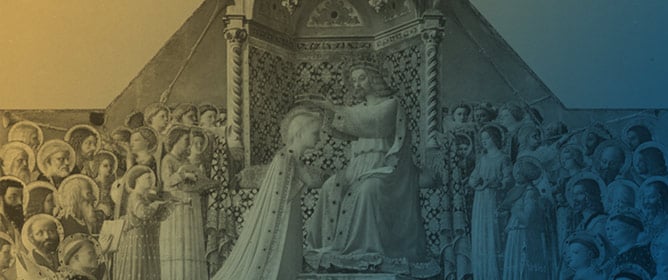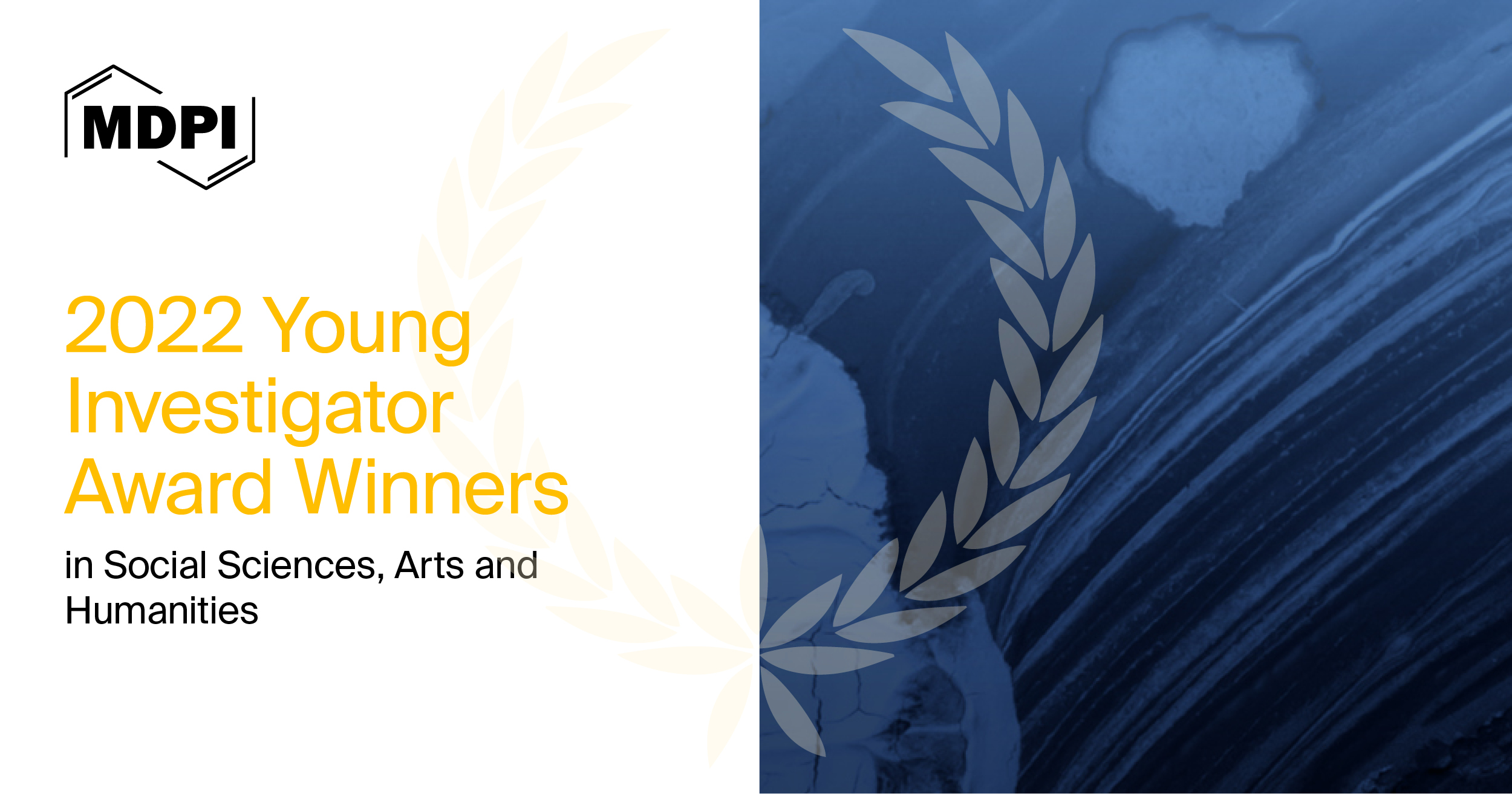Journal Description
Religions
Religions
is an international, interdisciplinary, peer-reviewed, open access journal on religions and theology, published monthly online by MDPI.
- Open Access— free for readers, with article processing charges (APC) paid by authors or their institutions.
- High Visibility: indexed within Scopus, AHCI (Web of Science), ATLA Religion Database, Religious and Theological Abstracts, and other databases.
- Journal Rank: CiteScore - Q1 (Religious Studies)
- Rapid Publication: manuscripts are peer-reviewed and a first decision is provided to authors approximately 20 days after submission; acceptance to publication is undertaken in 4.7 days (median values for papers published in this journal in the first half of 2023).
- Recognition of Reviewers: reviewers who provide timely, thorough peer-review reports receive vouchers entitling them to a discount on the APC of their next publication in any MDPI journal, in appreciation of the work done.
Impact Factor:
0.8 (2022)
Latest Articles
Toward a Natural Theology of Abundance: Reorientation to a Sacramental Reality
Religions 2023, 14(9), 1125; https://doi.org/10.3390/rel14091125 (registering DOI) - 01 Sep 2023
Abstract
This paper presents the Christian incorporation and transformation of the philosophical understanding of the relation between the material and immaterial. This transformation centers on the Incarnation of Christ, which changes both the relation or contact between the material and immaterial realms, and human
[...] Read more.
This paper presents the Christian incorporation and transformation of the philosophical understanding of the relation between the material and immaterial. This transformation centers on the Incarnation of Christ, which changes both the relation or contact between the material and immaterial realms, and human knowledge concerning the immaterial divine presence in material reality. More than a descriptive, historical account, the paper is primarily a conceptual presentation that retrieves the historically early thought of Irenaeus of Lyons and Athanasius of Alexandria to argue for a theological account of sacramental reality. Drawing on the metaphysical function of sacraments—themselves “visible signs of invisible grace”—which convey that there is more to material reality than meets the eye, I argue that this “more” implies what I call “a theology of abundance” that pertains to the whole of created reality, in the abundant nature of creation and of the human being in particular, and especially apparent in human knowing. The implication of such a theology of abundance is a comprehensive reorientation of human being, knowing, and expression in response to the invisible presence of the divine in visible, sacramental reality.
Full article
(This article belongs to the Special Issue Philosophy and Incarnation)
Open AccessArticle
Shaping Urban Religious Topography in the Iberian Peninsula between the Fourth and Sixth Centuries: “Coopetitive” Rivalry and Social Power
Religions 2023, 14(9), 1124; https://doi.org/10.3390/rel14091124 - 31 Aug 2023
Abstract
This study analyses the reshaping of the religious landscape of the cities of Hispania, from the disappearance of polytheistic sanctuaries to the construction of Christian churches, from the fourth to the middle of the sixth centuries CE. The focus is placed on the
[...] Read more.
This study analyses the reshaping of the religious landscape of the cities of Hispania, from the disappearance of polytheistic sanctuaries to the construction of Christian churches, from the fourth to the middle of the sixth centuries CE. The focus is placed on the agents who financed these complexes and the motivations behind their euergetic activities. The study highlights that the configuration of places of worship in the urban landscape was a contingent process often dependent on individual (layperson) initiative, challenging the widespread assumption that the Church and its bishops were the main promoters of urban redevelopment in Hispanic cities during this period.
Full article
(This article belongs to the Special Issue Continuing Tradition? Sacralization Practices in the Early Islamicate West and the Influence of Late Antiquity)
►▼
Show Figures

Figure 1
Open AccessArticle
1 Timothy 1:3–4 in the Memory of Irenaeus, Tertullian, Athanasius, and Chrysostom
Religions 2023, 14(9), 1123; https://doi.org/10.3390/rel14091123 - 31 Aug 2023
Abstract
In this article, I discuss reception history, its place within the history of historical critical methods, and social memory theory. I apply a reception historical lens buttressed by social memory theory to 1 Timothy 1:3–4. I show that the historical circumstances of this
[...] Read more.
In this article, I discuss reception history, its place within the history of historical critical methods, and social memory theory. I apply a reception historical lens buttressed by social memory theory to 1 Timothy 1:3–4. I show that the historical circumstances of this passage’s reception problematize using early understandings of it to reconstruct the referent behind “myths and endless genealogies”. I first show how the phrase “myths and endless genealogies” is ambiguous in the historical setting of the author. Then, I demonstrate that Irenaeus, Tertullian, Athanasius, and Chrysostom use this phrase against very different groups; however, all of these authors use 1 Timothy 1:4 for a (perceived) problem against their present group.
Full article
(This article belongs to the Special Issue Hermeneutics: Contextual Approaches to Biblical Interpretation)
Open AccessArticle
Rethinking Ricci’s Missionary Strategy: The Disputes between Buglio and Schall
by
Religions 2023, 14(9), 1122; https://doi.org/10.3390/rel14091122 - 31 Aug 2023
Abstract
During the late Ming Dynasty period, the Jesuits carried out a cultural accommodation strategy in China, commonly known as Ricci’s Strategy, due to the significant role played by Matteo Ricci (1552–1610) during this process. This strategy encompassed three elements: evangelizing through science and
[...] Read more.
During the late Ming Dynasty period, the Jesuits carried out a cultural accommodation strategy in China, commonly known as Ricci’s Strategy, due to the significant role played by Matteo Ricci (1552–1610) during this process. This strategy encompassed three elements: evangelizing through science and technology, establishing connections with the upper class, and compiling books to spread evangelism, all of which helped Catholicism to be promoted in China and be accepted by the Chinese people collectively. But the strategy also drew a lot of opposition within and outside of the Society of Jesus, some of which even led to the Rites Controversy. The extant literature primarily focuses on the conflicts that arose between the Society of Jesus and other religious orders, as well as the divergent viewpoints within the Society itself, like Niccolò Longobardo (1559–1654)’s well-documented anti-Riccian position. However, this approach largely ignored the disputes that arose within the Jesuit community in Beijing during the 17th century, mainly involving Ludovico Buglio (1606–1682) and Adam Schall (1592–1666) as two key figures on opposing sides. These disputes primarily centered around three points: the inclusion of superstitious elements in the calendar, the identities of the Jesuits in Early Qing, and the approach to inculturating theology. Although these historical events offered new perspectives and materials for the study of Ricci’s Strategy, they have received limited scholarly attention. This paper focuses on the disputes between Buglio and Schall, analyzing how Matteo Ricci’s Strategy was investigated during that time.
Full article
(This article belongs to the Special Issue The Catholic Encounter with Chinese Thought, Society and Politics in the Ming–Qing Dynasties)
Open AccessArticle
A Narrative Approach to Discerning Some Key Issues for Catholic Education in a More Synodal Church
Religions 2023, 14(9), 1121; https://doi.org/10.3390/rel14091121 - 30 Aug 2023
Abstract
Synodality is described as a mentality that esteems three actions: encountering, listening. and discerning. This mentality is applied to a discourse on Catholic education premised on three illustrative narratives. Narratives are used as a suitable instrument to gain deep insights into the lived
[...] Read more.
Synodality is described as a mentality that esteems three actions: encountering, listening. and discerning. This mentality is applied to a discourse on Catholic education premised on three illustrative narratives. Narratives are used as a suitable instrument to gain deep insights into the lived experience of teachers working in Catholic schools. Several concurrent themes are identified as emerging issues for a more synodal church. These include challenges in providing enough teachers to animate the religious identity of schools. This is linked to profound changes in patterns of religious affiliation that have been evident for several decades. Considering this, acknowledgement needs to be made that the lived experience of teachers entering Catholic education today is distinctive and different from previous generations. In light of this, a number of points of discernment are made. These include the need for ongoing, nuanced teacher recruitment and formation, as well as a reconceptualization of religious education (RE) to take into account changing cultural dynamics and providing more practical support for teachers, especially RE teachers.
Full article
(This article belongs to the Special Issue Catholic Education and Pope Francis’ Dream for a Synodal Church)
Open AccessArticle
Retrospective and Prospective Approaches to Christian Education in Church of Christ Schools in Zimbabwe
by
and
Religions 2023, 14(9), 1120; https://doi.org/10.3390/rel14091120 - 30 Aug 2023
Abstract
This article explores the past, present, and future of Christian education (CE) in the Church of Christ in Zimbabwe (COCZ) schools under the Dadaya, Mashoko, and Chidamoyo clusters. It highlights the retrospective and prospective aspects of CE within the church by emphasizing the
[...] Read more.
This article explores the past, present, and future of Christian education (CE) in the Church of Christ in Zimbabwe (COCZ) schools under the Dadaya, Mashoko, and Chidamoyo clusters. It highlights the retrospective and prospective aspects of CE within the church by emphasizing the adaptability, collaboration, and utilization of contemporary tools and resources to effectively carry out the mission of CE in Zimbabwean schools. It acknowledges the strong historical foundation of COCZ schools in providing biblical teachings, moral formation, and faith integration. However, it also highlights the challenges faced by the COCZ in maintaining this foundation posed by church politics and oppressive family ministries. This study assesses the patterns, dynamics, and consequences of intentional CE influenced by the COCZ’s ethical and moral principles, commonly known as the Restoration Movement principles or the Stone–Campbell theories of “restoring the church to its first century forms”. It recognizes the impact of COCZ school education on the development of church leaders as well as civil and secular leaders from COCZ-mission school graduates. However, it acknowledges that the historical foundation has been gradually fading in the post-missionary era. Looking ahead, this article emphasizes the need for a comprehensive and holistic approach to CE that addresses all aspects of individuals’ well-being in that church. This includes adapting to societal changes, developing CE-conscious leaders, engaging in community outreach, embracing digital tools and resources, and fostering collaborative networks with other CE-conscious church schools and institutions. This article suggests that by embracing these prospects, the COCZ can enhance its commitment to CE and positively impact the lives of its members and the wider community at its mission stations. Using WhatsApp interviews for data collection, it discusses these prospects by focusing on transformative leadership, embracing diversity, effective communication, and addressing power dynamics to facilitate the church’s mission and vision in Zimbabwe.
Full article
(This article belongs to the Special Issue Christian Education: Retrospects and Prospects)
Open AccessFeature PaperArticle
Revisiting Secularization in Light of Growing Diversity: The European Case
by
Religions 2023, 14(9), 1119; https://doi.org/10.3390/rel14091119 - 30 Aug 2023
Abstract
This article brings together two rather different trends in the religious life of twenty-first century Europe. On the one hand, secularization continues—faster in some places than others and with varying implications for the society in question. On the other, Europe—and especially western Europe—is
[...] Read more.
This article brings together two rather different trends in the religious life of twenty-first century Europe. On the one hand, secularization continues—faster in some places than others and with varying implications for the society in question. On the other, Europe—and especially western Europe—is becoming increasingly diverse, an equally inexorable development brought about by immigration. Is it possible to reconcile the two, keeping in mind that secularization erodes religious literacy, thus impeding constructive conversation about religion in public life, whereas the management of religious diversity demands this capacity on an almost daily basis? All too often the result is an ill-informed and ill-mannered debate. Can anything be done? Is it possible, in other words, to encourage a better conversation about religion in this part of the world? Understanding the religious dimensions of the current conflict in Ukraine raises similar—but distinctive—issues; they are central to the underlying discussion.
Full article
(This article belongs to the Special Issue Religion, Quo Vadis? Secularization in the Modern World)
►▼
Show Figures
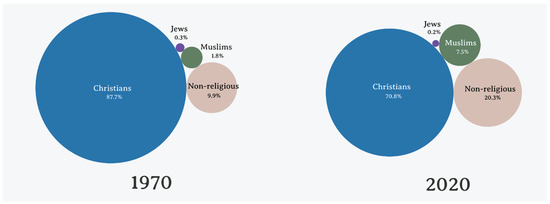
Figure 1
Open AccessArticle
The Possibility of Asking about Dao: On the Philosophical Significance of Dialogue in the Zhuangzi
by
Religions 2023, 14(9), 1118; https://doi.org/10.3390/rel14091118 - 30 Aug 2023
Abstract
In contrast to the aphoristic style of the Daodejing, Zhuangzi is known for its abundant use of dialogues. These dialogues, especially those found in chapters 21 and 22, are consciously organized around the theme of “asking about Dao”. They bring together the
[...] Read more.
In contrast to the aphoristic style of the Daodejing, Zhuangzi is known for its abundant use of dialogues. These dialogues, especially those found in chapters 21 and 22, are consciously organized around the theme of “asking about Dao”. They bring together the diverse propositions about the Dao that are found independently throughout the Daodejing. The purpose of this paper is to highlight the fact that Zhuangzi consciously orders these propositions in terms of the different levels of knowledge of Dao. Within this theoretical framework, Zhuangzi further ranks the questions and answers regarding these propositions. Certain dialogues are partly dismissed because both participants demonstrate a flawed and shallow understanding of the Dao, while other questions and answers are acknowledged and appreciated for their correct and profound understanding of it. There is a strict corresponding relationship between levels of knowledge of Dao and different attitudes toward dialogues in it. Therefore, the examination of the dialogues about the Dao reveals that Zhuangzi places explicit emphasis on the knowledge of the Dao compared to the Daodejing, which also sheds light on Zhuangzi’s distinctive awareness of the problems surrounding this key concept.
Full article
(This article belongs to the Special Issue New Pathways into Early Daoist Philosophy)
Open AccessArticle
Holistic Wisdom from Abrahamic Faiths’ Earliest Encounters with Ancient China: Towards a Constructive Chinese Natural Theology
Religions 2023, 14(9), 1117; https://doi.org/10.3390/rel14091117 - 29 Aug 2023
Abstract
Philosophies in the East and West have favored wisdom in their search for truths. The Chinese civilization has sought holistic wisdom in its long history of absorbing the Abrahamic faiths since the seventh century. This paper aims to investigate how the Abrahamic faiths
[...] Read more.
Philosophies in the East and West have favored wisdom in their search for truths. The Chinese civilization has sought holistic wisdom in its long history of absorbing the Abrahamic faiths since the seventh century. This paper aims to investigate how the Abrahamic faiths have interacted with ancient Chinese culture. In particular, this paper will examine the earliest written records in Chinese of the Luminous Religion (or Jingjiao), the earliest Jews in Kaifeng, and the earliest Muslims in China. By analyzing their theology of creation with reference to the Holy Spirit and qi (wind/breath/pneuma), this paper attempts a constructive Chinese natural theology based on a sympathetic and critical assessment of Alister McGrath’s natural theology but makes up for his spirit deficit. This paper argues that the holistic wisdom achieved in the early integration process of the Abrahamic faiths with the Chinese culture is closely intertwined with the Spirit and qi, which provides a fruitful ground to construct a Chinese natural theology. The contribution of this paper lies in its original research into the earliest written records of the three Abrahamic faiths in China from the perspective of the doctrine of creation and its relationship with the Spirit and qi.
Full article
(This article belongs to the Special Issue World Christianity in History and in Culture)
Open AccessArticle
The Holy See and Disability Sport: From Attention to Commitment
Religions 2023, 14(9), 1116; https://doi.org/10.3390/rel14091116 - 29 Aug 2023
Abstract
Research overviews of and historiography on the attitude of the Catholic Church and theologians towards athletes with intellectual and physical disabilities assume that the Church and theologians have only very recently begun to interest themselves in this subject. Starting from John Paul II’s
[...] Read more.
Research overviews of and historiography on the attitude of the Catholic Church and theologians towards athletes with intellectual and physical disabilities assume that the Church and theologians have only very recently begun to interest themselves in this subject. Starting from John Paul II’s contribution to this field, and above all from his integral anthropological vision, this article assesses his position by comparing it with that of his two successors Benedict XVI and Francis. Especially the latter’s addresses and interviews and the official documents on sport issued by the Holy See during his pontificate are testimony to his special commitment to athletes with disabilities. The article also examines the history of the Holy See and studies its attention to athletes with a disability. The results of this inquiry are that papal interest in this field is not limited to, nor did it start with the pontificate of John Paul II. Instead, it dates from the very beginning of the modern phenomenon of sport, with Pope Pius X at the beginning of the 20th century, continued by Pius XII and John XXIII. The latter’s speech to the participants of the first Paralympic Games in 1960 is the strongest indication of a pre-John Paul II affirmation of disabled sport. This points to the importance of taking a more nuanced position in the current debate, although it is clear that Pope Francis must be considered the champion of the Holy See’s commitment to the inclusion of athletes with a disability.
Full article
(This article belongs to the Special Issue Sport and Religion: Continuities, Connections, Concerns)
Open AccessArticle
A Dilemma for Theistic Non-Naturalism
Religions 2023, 14(9), 1115; https://doi.org/10.3390/rel14091115 - 29 Aug 2023
Abstract
Non-naturalism is the view that there are sui generis, non-natural moral properties. This paper poses a dilemma for theists who accept this view. Either God explains why non-moral properties make sui generis, non-natural moral properties obtain, or God does not explain this. If
[...] Read more.
Non-naturalism is the view that there are sui generis, non-natural moral properties. This paper poses a dilemma for theists who accept this view. Either God explains why non-moral properties make sui generis, non-natural moral properties obtain, or God does not explain this. If the former, then God is unacceptably involved in the explanation of his own moral goodness. If the latter, then God’s sovereignty, stature, and importance are undermined, and an unacceptable queerness is introduced into the world. This paper concludes that theists have good reasons to reject non-naturalism on account of the unacceptable consequences of accepting either horn.
Full article
(This article belongs to the Special Issue Morality without God: Reality or Illusion?)
Open AccessArticle
Miracle Stories in Motion—On the Three Editions of Guangshiyin Yingyanji
by
Religions 2023, 14(9), 1114; https://doi.org/10.3390/rel14091114 - 28 Aug 2023
Abstract
Previous studies have assumed that the purpose of Yingyanji was to produce texts that are proselytistic or evangelical. Through the analysis of Guangshiyin Yingyanji, we find that lay people have created Yingyanji for a long time. Its main purpose was not to
[...] Read more.
Previous studies have assumed that the purpose of Yingyanji was to produce texts that are proselytistic or evangelical. Through the analysis of Guangshiyin Yingyanji, we find that lay people have created Yingyanji for a long time. Its main purpose was not to spread religion, but to record regional memories and family beliefs, which were mainly circulated among friends and relatives. Moreover, the miracle stories contained in Guangshiyin Yingyanji often have different versions within the three systems of Zhiguai, Yingyan, and Gantong. Through an analysis of these different versions, we can better grasp the purpose of rewriting texts under different systems, and the struggle for ideas which they embody.
Full article
(This article belongs to the Special Issue Buddhist Narrative Literature)
►▼
Show Figures

Figure 1
Open AccessArticle
Religious Materiality and Virtual Sainthood: The Case of Shna Ndou (St. Anthony) Pilgrimage in Laç
Religions 2023, 14(9), 1113; https://doi.org/10.3390/rel14091113 - 28 Aug 2023
Abstract
The interdisciplinary perspective, between history and anthropology, of our contribution has as its subject the pilgrimage at Kisha e Shna Ndout (Sanctuary of St. Anthony of Padua) in Laç, northern Albania, which is one of the most visited religious sites in southeastern Europe.
[...] Read more.
The interdisciplinary perspective, between history and anthropology, of our contribution has as its subject the pilgrimage at Kisha e Shna Ndout (Sanctuary of St. Anthony of Padua) in Laç, northern Albania, which is one of the most visited religious sites in southeastern Europe. The church, built there and ministered by Franciscans, is now an impressive place of worship frequented throughout the year by thousands of pilgrims. On the 12th and 13th of June of each year, an official pilgrimage is held, which reaches its climax on the night of the 12th, when thousands of Albanians sleep in the shrine seeking blessings and healing. The pilgrimage practices show how materiality is a privileged means of reaching out to a religious place. This materiality is grounded in the multilayered built environment, which has been built and rebuilt and especially reconstructed after the collapse of the socialist regime—a process that reveals the pivotal function of secular infrastructures in the case of religious places. Virtuality is also an important aspect of the pilgrimage, and so materiality and virtuality form a single milieu that reshapes perceptions. Through participation in this pilgrimage, virtuality is sacralized and promotes sanctity.
Full article
(This article belongs to the Special Issue The Transformation of Pilgrimage Studies)
►▼
Show Figures
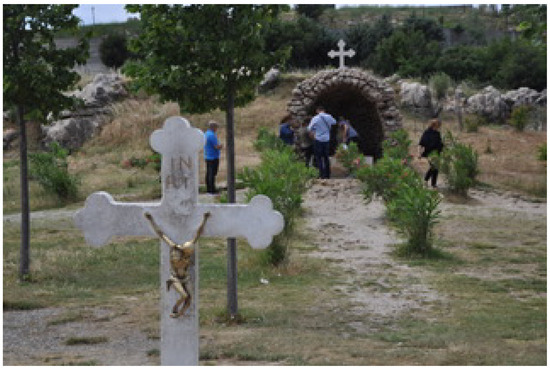
Figure 1
Open AccessArticle
“Maybe I Need Christ or Maybe I Just Need Me”: Functions of Religion among Young Black Members of the LGBTQIA Community in the United States
Religions 2023, 14(9), 1112; https://doi.org/10.3390/rel14091112 - 28 Aug 2023
Abstract
This qualitative study examines the functions of religion for a group of 76 young Black members of the LGBTQIA community ages 18–30 years old based on the question: What are some of the functions of religion that make continued congregational involvement viable for
[...] Read more.
This qualitative study examines the functions of religion for a group of 76 young Black members of the LGBTQIA community ages 18–30 years old based on the question: What are some of the functions of religion that make continued congregational involvement viable for members of this community? Emerging adulthood theory suggests that late adolescence is a period of self-discovery and societal critique. To my knowledge, this theory has not been used to study the religious experiences of young Black sexual minorities. Content analysis shows the functions of religion as a controlling mechanism during childhood, a conflict mechanism during teen years, and religion/spirituality as a cathartic mechanism during late adolescence.
Full article
(This article belongs to the Special Issue The Functions of Religion for Human Society)
Open AccessArticle
Laudato Si’ and Spatial Turn: A Theological Approach
Religions 2023, 14(9), 1111; https://doi.org/10.3390/rel14091111 - 28 Aug 2023
Abstract
This article analyses the encyclical letter Laudato Si’ against the backdrop of the contemporary and theological “spatial turn”. It asks if and how Laudato Si’ incorporates the main elements of this movement that pushes for a reappraisal of space and/or place in theological
[...] Read more.
This article analyses the encyclical letter Laudato Si’ against the backdrop of the contemporary and theological “spatial turn”. It asks if and how Laudato Si’ incorporates the main elements of this movement that pushes for a reappraisal of space and/or place in theological reasoning. This inquiry is motivated by a public and constructive understanding of theology, with the conviction that it too should bring its specific contribution to the challenges of the “Common Home”. The article starts by characterizing this theological “spatial turn”, and by putting it into the context of similar trends in other human and social sciences. Secondly, it focuses on the analysis of Laudato Si’, namely by considering the role played in it by spatiality. Thirdly, and in a brief systematic way, it presents some concluding remarks that describe how Laudato Si’ may be interpreted in the “spatial turn” framework. Following these remarks, the article concludes that there is a moderate incorporation in Laudato Si’ of the concerns that promote and sustain a theological “spatial turn”.
Full article
(This article belongs to the Special Issue Religion and Public Agenda: Complexity and the Challenges of the Common Home)
Open AccessArticle
Shifting Gears or Splitting Hairs? Performance Criticism’s Object of Study
Religions 2023, 14(9), 1110; https://doi.org/10.3390/rel14091110 - 28 Aug 2023
Abstract
In keeping with the call of this Special Issue, this article is but one voice in the midst of a much broader conversation, attending to whether the differences between narrative and performance criticism are a matter of degree or kind. Narrative and biblical
[...] Read more.
In keeping with the call of this Special Issue, this article is but one voice in the midst of a much broader conversation, attending to whether the differences between narrative and performance criticism are a matter of degree or kind. Narrative and biblical performance criticisms are natural bedfellows. The two appear genealogically related as they share similar founders, attend to similar features, and to a degree share similar interests with regard to interpretation. In fact, their interests appear to be so closely aligned at several points that attempts to distinguish between these two approaches run the risk of simply “splitting hairs”. Yet, our recognition of these distinctions is essential for highlighting the unique contribution of each approach. In what follows, I suggest that the differences between performance and narrative criticisms are rather (at least theoretically) a “shifting of gears”, a progression toward a more complex understanding of how biblical texts work in various contexts and how we as scholars may approach them as objects of study. While the object of study in narrative criticism is relatively well established (again, at least theoretically), this is not necessarily the case for performance criticism. In short, by way of contrast, I will suggest that for performance criticism, its object is similar to yet distinct from the object of study of narrative criticism. Such a claim is by no means groundbreaking, especially among the performance critics, nor should it necessarily be viewed as controversial. Rather, in exploring the contours of each approach, this contribution aims to provide additional theoretical credence to certain areas within this conversation. In doing so, this inadvertently has implications not only for our thinking in this particular volume, but also perhaps more broadly for biblical studies.
Full article
(This article belongs to the Special Issue Narrative and Performance Criticisms—A Difference of Degree or Kind?)
Open AccessArticle
Flesh, Body, World: Michel Henry on Incarnation
Religions 2023, 14(9), 1109; https://doi.org/10.3390/rel14091109 - 28 Aug 2023
Abstract
Henry tirelessly insists that all flesh is an invisible, radically immanent, impressional material in which life arrives in itself. But this raises a theological problem: is the material, visible body of Christ to be excluded from what we understand by incarnation? To answer
[...] Read more.
Henry tirelessly insists that all flesh is an invisible, radically immanent, impressional material in which life arrives in itself. But this raises a theological problem: is the material, visible body of Christ to be excluded from what we understand by incarnation? To answer this and related questions, the problematic of the duplicity of appearing—the appearing of life and the appearing of the world—must be clarified. It is precisely through an analysis of flesh that Henry seeks to establish a rapport between the two modes of appearing, so a study of the flesh should allow us to articulate in one stroke an account of our access to the world and the thingly body. Against a simplistic reading that claims that, for Henry, an unbridgeable gorge separates life and the world, the flesh and the body, I argue that the objective, visible body is real, but that its reality is founded on the more immediate reality of the flesh. I use the results of this inquiry to argue further for two distinct but related senses of the concept “world”, one which names a phenomenological reality and another that picks out an ideological aberration endemic to modernity. While the flesh opens up the reality of the former, the latter is an imaginary and impossible world.
Full article
(This article belongs to the Special Issue Philosophy and Incarnation)
Open AccessArticle
Revivalism and Decoloniality: The Paradox of Modernization without Westernization in the Political Theology of Israr Ahmad
Religions 2023, 14(9), 1108; https://doi.org/10.3390/rel14091108 - 27 Aug 2023
Abstract
This article explores the contribution of modern Muslim revivalism to Muslims’ political decolonization, and the paradoxical role the West plays in that process. On the one hand, revivalism rejects the founding principles of liberal political theory, and on the other hand, it readily
[...] Read more.
This article explores the contribution of modern Muslim revivalism to Muslims’ political decolonization, and the paradoxical role the West plays in that process. On the one hand, revivalism rejects the founding principles of liberal political theory, and on the other hand, it readily adopts the salient structures and mechanisms of the modern polity with a view to Islamize them, all the while insisting on the Muslims’ need to de-Westernize. Toward revealing the hitherto neglected dimensions of revivalism, my analysis adopts an unconventional route by subjecting revivalism to a semiotic analysis in conversation with the archetypal theories of Mircea Eliade and Carl G. Jung. The analysis unveils the universal psychological structures of revival, and their specific Muslim symbolization. I conclude (a) that depth psychology makes modern Muslim revival inevitable, which will only grow stronger and gain wider appeal while the Muslims continue to suffer decline; (b) that among the different forms of Muslim revival, revivalism ventures the farthest in decolonizing Muslim political imagination; (c) that the revivalist imagination makes their espoused caliphate imperative for the purpose of ritual participation in Islam’s sacred origins; and (d) that a critical reconstruction and evolution of revivalism holds out the promise of a greater contribution to Muslim decolonization. For my analysis, I largely turn to the Pakistani political theologian Israr Ahmad (d. 2010), whose ideas have been disseminated widely across the Muslim world, yet who has not received the requisite academic scrutiny. Moreover, intra-revivalist critique of revivalism has been a neglected aspect in the study of revival, and its careful scrutiny should become a topic of investigation in its own right. In that regard, Ahmad offers a most important critique of earlier revival efforts and their entanglement with certain aspects of coloniality.
Full article
(This article belongs to the Special Issue Islamic Reformism with and without the West: Mapping Religious Reformist Discourses in Contemporary Islam)
Open AccessFeature PaperArticle
Religious Heritage Complex and Authenticity: Past and Present Assemblages of One Cypriot Icon
Religions 2023, 14(9), 1107; https://doi.org/10.3390/rel14091107 - 26 Aug 2023
Abstract
Drawing on data from ethnographic fieldwork, this study focuses on an icon known as Panagia Amirou kept at the Amirou Monastery in Cyprus. Instead of analyzing its unusual form, consisting of two icons from different times inserted one into another, this paper uses
[...] Read more.
Drawing on data from ethnographic fieldwork, this study focuses on an icon known as Panagia Amirou kept at the Amirou Monastery in Cyprus. Instead of analyzing its unusual form, consisting of two icons from different times inserted one into another, this paper uses the concept of “religious heritage complex” to understand the special status of the icon, the complexity of the assemblages it has joined over time, and the relationships between religion and heritage. The Panagia Amirou icon has become the symbol of the monastery and appears to be crucial for the creation of a shared identity by giving the community the feeling of a connection to the past and continuity of monastic tradition, for as they believe, the icon and the monastery are from the same time. Particular attention is paid to the process of authenticating the icon’s special status. The legend recounts not only the icon’s old age but also its miraculous appearance and the healing power inherent in it from the very beginning, so it authenticates, together with processions, not only the alleged connection of the icon with the beginning of the monastery but also the status of the icon as being miracle-working.
Full article
(This article belongs to the Special Issue Sacred Heritage: Religions and Material Culture)
►▼
Show Figures
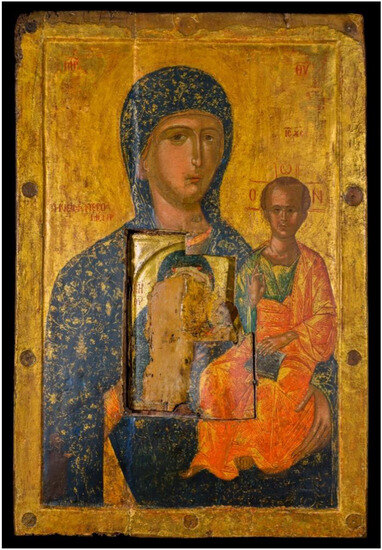
Figure A1
Open AccessArticle
Forgiving Others: Pastoral Care of Forgiveness in Post-Secular Societies
Religions 2023, 14(9), 1106; https://doi.org/10.3390/rel14091106 - 26 Aug 2023
Abstract
This article argues that pastoral insights into the dynamics of forgiveness are also relevant for pastoral care in post-secular society. While receiving forgiveness has been the raison d’etre of the sacrament of penance (a historical precursor to modern pastoral care), contemporary post-secular societies
[...] Read more.
This article argues that pastoral insights into the dynamics of forgiveness are also relevant for pastoral care in post-secular society. While receiving forgiveness has been the raison d’etre of the sacrament of penance (a historical precursor to modern pastoral care), contemporary post-secular societies accentuate the problem of forgiving others. This article explores several paths for forgiving others that care seekers can walk, guided by pastors who provide maps and signposts. Methodologically, this article analyzes two pastoral care conversations about forgiving others, published in a Danish podcast series on the official homepage of the Evangelical Lutheran Church of Denmark. These two conversations present a highway of unconditional forgiveness, in contrast to the dead end of not being able to forgive. This article explores how pastors can care for care seekers along these diametric roads, and along several byways, through surveys of relevant (theological) philosophy, systematic theology, and theology of pastoral care. The two care seekers are neither religious nor simply secular; they are post-secular, moving in and out of secular and religious discourses as appears relevant. The article concludes with reflections on pastoral care in different intercultural settings, specifically in post-secular societies.
Full article
(This article belongs to the Special Issue Pastoral and Spiritual Care in Pluralistic Societies)
Highly Accessed Articles
Latest Books
E-Mail Alert
News
Topics
Topic in
Education Sciences, Languages, Religions, Sustainability
From Education and Humanities to Improve Knowledge, Society and the Digital Transformation
Topic Editors: Rosabel Roig-Vila, Jordi M. Antolí-Martínez, Antonio Cortijo, Vicent Martines, Santiago Mengual Andrés, Elena Sánchez-López, Fabrizio Manuel Sirignano, Alexander López PadrónDeadline: 30 December 2023

Conferences
Special Issues
Special Issue in
Religions
Spirituality, Resilience and Posttraumatic Growth
Guest Editors: Heather Boynton, Jo-Ann VisDeadline: 1 September 2023
Special Issue in
Religions
Institutional Settings for the Teaching and Research Related to the Hebrew Bible/Old Testament and Ancient Israel
Guest Editor: Joel GereboffDeadline: 15 September 2023
Special Issue in
Religions
Pentecost at the Margins: Explorations in Marginalisation and Christianity
Guest Editor: Tanya RichesDeadline: 30 September 2023
Special Issue in
Religions
Research of Jewish Communities in Africa and in Their Diaspora
Guest Editor: Rachel SharabyDeadline: 10 October 2023
Topical Collections
Topical Collection in
Religions
Measures of the Different Aspects of Spirituality/Religiosity
Collection Editor: Arndt Büssing


